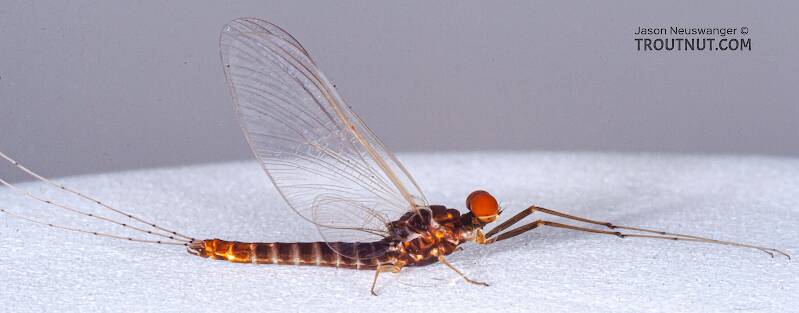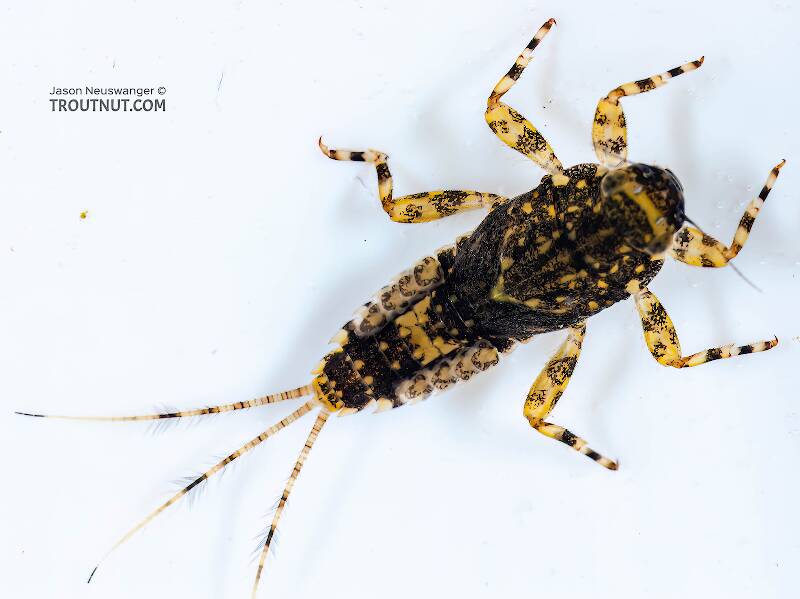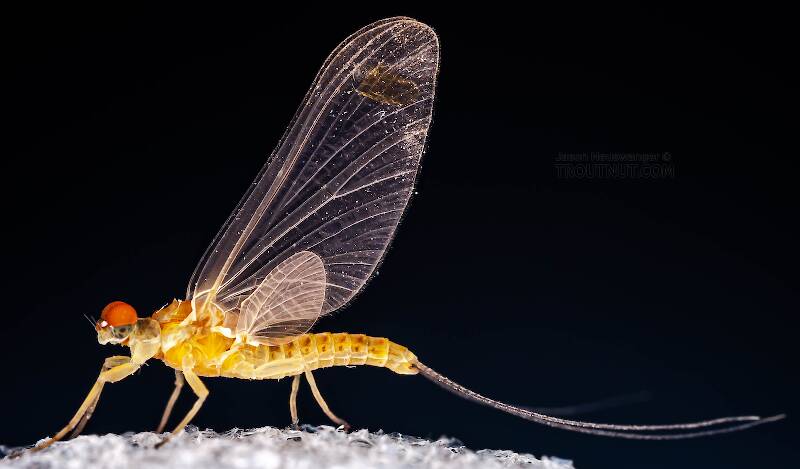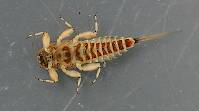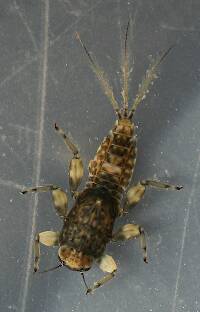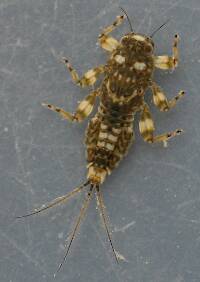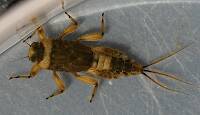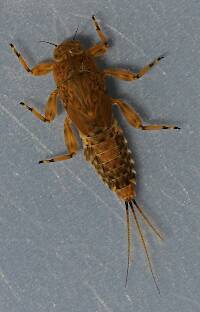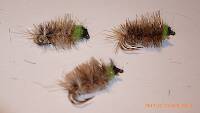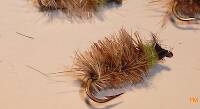
Hex Mayflies
Hexagenia limbata
The famous nocturnal Hex hatch of the Midwest (and a few other lucky locations) stirs to the surface mythically large brown trout that only touch streamers for the rest of the year.
Featured on the forum

This is an interesting one. Following the keys in Merritt R.W., Cummins, K.W., and Berg, M.B. (2019) and Jacobus et al. (2014), it keys clearly to Ephemerella. Jacobus et al provide a key to species, but some of the characteristics are tricky to interpret without illustrations. If I didn't make any mistakes, this one keys to Ephemerella mucronata, which has not previously been reported any closer to here than Montana and Alberta. The main character seems to fit well: "Abdominal terga with prominent, paired, subparallel, spiculate ridges." Several illustrations or descriptions of this holarctic species from the US and Europe seem to match, including the body length, tarsal claws and denticles, labial palp, and gill shapes. These sources include including Richard Allen's original description of this species in North America under the now-defunct name E. moffatae in Allen RK (1977) and the figures in this description of the species in Italy.

Troutnut is a project started in 2003 by salmonid ecologist Jason "Troutnut" Neuswanger to help anglers and
fly tyers unabashedly embrace the entomological side of the sport. Learn more about Troutnut or
support the project for an enhanced experience here.
This topic is about the Mayfly Species Ephemerella invaria
This species, the primary "Sulphur" hatch, stirs many feelings in the angler. There is nostalgia for days when everything clicked and large, selective trout were brought to hand. There is the bewildering memory of towering clouds of spinners which promise great fishing and then vanish back into the aspens as night falls. There is frustration from the maddening selectivity with which trout approach the emerging duns--a vexing challenge that, for some of us, is the source of our excitement when Sulphur time rolls around.Ephemerella invaria is one of the two species frequently known as Sulphurs (the other is Ephemerella dorothea). There used to be a third, Ephemerella rotunda, but entomologists recently discovered that invaria and rotunda are a single species with an incredible range of individual variation. This variation and the similarity to the also variable dorothea make telling them apart exceptionally tricky.
As the combination of two already prolific species, this has become the most abundant of all mayfly species in Eastern and Midwestern trout streams.
Example specimens
CharlieBugs
Posts: 1
Posts: 1
CharlieBugs on Jan 25, 2015January 25th, 2015, 8:08 pm EST
Your post on Ephemerella subvaria brought back some memories that might be of interest to some readers.
I got my master’s degree under Ed Cooper at Penn State in 1966. I studied the impact of low oxygen from Penn State’s sewage plant on the mayflies of Spring Creek. The plant mostly removed BOD (organic matter which causes low oxygen) by oxidizing it in a bacteria rich environment. But at that time the plant did not remove phosphorus (and nitrogen) which fertilized the macrophytic algae and other plant growth. There were far more macrophytes (large plants) in Spring Creek below the sewage plant entrance than above, and essentially no mayflies. What was there in the effluent that killed the mayflies? Mayflies put directly in the effluent did not die over a 16 hour day. But oxygen samples taken over 24 hours in summer showed a much greater variation below the effluent (from 16 ppm (or mg/l), 160% of saturation in late afternoon) to 3 ppm (30 percent saturation just before dawn) (vs 14 to 10 ppm, +- 20 percent saturation above the effluent.
I built a Rube Goldberg machine in the lab that would control the oxygen levels and temperature of control and experimental cages that each held 25 mayflies. The control would keep oxygen near saturation and the experimental one would lower the oxygen over 8 hours (the length of night in summer). Mortality was dependent upon both oxygen level and temperature. Virtually no mayflies would die if the oxygen was above 2 PPM (or mg/l) at 8 C, or at 4.5 at 20 C. Seventy five percent of larvae would die at 1 ppm at 8 degrees and 2.5 ppm at 20 degrees. So the mortality was much more if the temperatures were high. Hence most of the mortality would presumably occur in August when the high temperatures (20C) would increase the larvae metabolism and hence need for oxygen, but the water would hold less oxygen even before the night-time respiration of the macrophytes would reduce it much further (to only 3 ppm). Thus the low nighttime oxygen caused by excessive plant growth was a sufficient cause or the near total absence of mayflies below the sewage plant. Recognizing the aquatic impact Penn State started to use land disposal of its effluent which as far as I knew alleviated, and even stopped, the negative impacts on the mayflies. Can anyone verify this ? The otherwise well done “The Fishery of Spring Creek; A Watershed Under Siege “
By Robert F. Carline, Rebecca L. Dunlap Jason E. Detar, Bruce A. Hollender Has nothing on dissolved oxygen or aquatic insects. In my opinion we need much more of an ecosystems approach for streams (Which we are doing for Little Sandy Creek in N.Y.).
Now back to Ephemeralla subvaria. The title of the paper I published on this project (my first of nearly 300 publications) was:
1. Hall, C.A.S. 1969. Mortality of the mayfly nymph, Ephemerella rotunda, at low dissolved oxygen concentrations. J. Elisha Mitchell Sci. Soc. 85(1): 34-39 (M.S. Thesis, Pennsylvania State University, 1966).
Whoa! Ephemeralla rotunda? This was by far the most abundant mayfly in Spring Creek where I sampled! But I could not even find the name in your list. Also I had my samples verified by Burke, author of the authoritative "Mayflies of Illinois", and he said Well that’s what it keyed out to in my book”. (Talk about scientific ass covering! ) Well to make matters worse (as of 24 hours ago) my next girlfriend, Molly, at the University of North Carolina, loved the name of “Ephemerella rotunda”, the rotund one, which comes to think of it described her as well. I liked it too. But n’exist plus: where had the most abundant mayfly gone? Fortunately upon reading the rest of the post I found “Ephemerella invaria is one of the two species frequently known as Sulphurs (the other is Ephemerella dorothea). There used to be a third, Ephemerella rotunda, but entomologists recently discovered that invaria and rotunda are a single species with an incredible range of individual variation." Ahh neither rotunda nor Molly stood the test of time. So I assume what I called rotunda is still alive and well in Spring Creek as invaria. Again, can anyone verify that?
If anyone wants to follow up on the distribution and abundance of mayfly (or any other species) may I recommend: Hall, C.A.S., J.A. Stanford and R. Hauer. 1992. The distribution and abundance of organisms as a consequence of energy balances along multiple environmental gradients. Oikos 65: 377-390. I can send it if you cannot get it from google, which I think you can. (chall@esf.edu)
I got my master’s degree under Ed Cooper at Penn State in 1966. I studied the impact of low oxygen from Penn State’s sewage plant on the mayflies of Spring Creek. The plant mostly removed BOD (organic matter which causes low oxygen) by oxidizing it in a bacteria rich environment. But at that time the plant did not remove phosphorus (and nitrogen) which fertilized the macrophytic algae and other plant growth. There were far more macrophytes (large plants) in Spring Creek below the sewage plant entrance than above, and essentially no mayflies. What was there in the effluent that killed the mayflies? Mayflies put directly in the effluent did not die over a 16 hour day. But oxygen samples taken over 24 hours in summer showed a much greater variation below the effluent (from 16 ppm (or mg/l), 160% of saturation in late afternoon) to 3 ppm (30 percent saturation just before dawn) (vs 14 to 10 ppm, +- 20 percent saturation above the effluent.
I built a Rube Goldberg machine in the lab that would control the oxygen levels and temperature of control and experimental cages that each held 25 mayflies. The control would keep oxygen near saturation and the experimental one would lower the oxygen over 8 hours (the length of night in summer). Mortality was dependent upon both oxygen level and temperature. Virtually no mayflies would die if the oxygen was above 2 PPM (or mg/l) at 8 C, or at 4.5 at 20 C. Seventy five percent of larvae would die at 1 ppm at 8 degrees and 2.5 ppm at 20 degrees. So the mortality was much more if the temperatures were high. Hence most of the mortality would presumably occur in August when the high temperatures (20C) would increase the larvae metabolism and hence need for oxygen, but the water would hold less oxygen even before the night-time respiration of the macrophytes would reduce it much further (to only 3 ppm). Thus the low nighttime oxygen caused by excessive plant growth was a sufficient cause or the near total absence of mayflies below the sewage plant. Recognizing the aquatic impact Penn State started to use land disposal of its effluent which as far as I knew alleviated, and even stopped, the negative impacts on the mayflies. Can anyone verify this ? The otherwise well done “The Fishery of Spring Creek; A Watershed Under Siege “
By Robert F. Carline, Rebecca L. Dunlap Jason E. Detar, Bruce A. Hollender Has nothing on dissolved oxygen or aquatic insects. In my opinion we need much more of an ecosystems approach for streams (Which we are doing for Little Sandy Creek in N.Y.).
Now back to Ephemeralla subvaria. The title of the paper I published on this project (my first of nearly 300 publications) was:
1. Hall, C.A.S. 1969. Mortality of the mayfly nymph, Ephemerella rotunda, at low dissolved oxygen concentrations. J. Elisha Mitchell Sci. Soc. 85(1): 34-39 (M.S. Thesis, Pennsylvania State University, 1966).
Whoa! Ephemeralla rotunda? This was by far the most abundant mayfly in Spring Creek where I sampled! But I could not even find the name in your list. Also I had my samples verified by Burke, author of the authoritative "Mayflies of Illinois", and he said Well that’s what it keyed out to in my book”. (Talk about scientific ass covering! ) Well to make matters worse (as of 24 hours ago) my next girlfriend, Molly, at the University of North Carolina, loved the name of “Ephemerella rotunda”, the rotund one, which comes to think of it described her as well. I liked it too. But n’exist plus: where had the most abundant mayfly gone? Fortunately upon reading the rest of the post I found “Ephemerella invaria is one of the two species frequently known as Sulphurs (the other is Ephemerella dorothea). There used to be a third, Ephemerella rotunda, but entomologists recently discovered that invaria and rotunda are a single species with an incredible range of individual variation." Ahh neither rotunda nor Molly stood the test of time. So I assume what I called rotunda is still alive and well in Spring Creek as invaria. Again, can anyone verify that?
If anyone wants to follow up on the distribution and abundance of mayfly (or any other species) may I recommend: Hall, C.A.S., J.A. Stanford and R. Hauer. 1992. The distribution and abundance of organisms as a consequence of energy balances along multiple environmental gradients. Oikos 65: 377-390. I can send it if you cannot get it from google, which I think you can. (chall@esf.edu)
Entoman on Jan 25, 2015January 25th, 2015, 8:46 pm EST
Welcome to the forum CharlieBugs and thank you for sharing that interesting info.
The quick answer to both questions is yes. Advances in cladistics and genetics as well as more complete studies of their nymphal stages have shown that the two forms thought of previously as different species are now considered synonymous. Under the rules of nomenclature governing the scientific names of species, pride of place goes to the older name. So the name rotunda is now considered obsolete.
Poor rotunda is not alone in this. Massive revisions have occurred in the Ephemeroptera over the last few decades with more promised - much to the consternation of many in the angling community trying desperately to keep up! :)
So I assume what I called rotunda is still alive and well in Spring Creek as invaria. Again, can anyone verify that?
The quick answer to both questions is yes. Advances in cladistics and genetics as well as more complete studies of their nymphal stages have shown that the two forms thought of previously as different species are now considered synonymous. Under the rules of nomenclature governing the scientific names of species, pride of place goes to the older name. So the name rotunda is now considered obsolete.
Poor rotunda is not alone in this. Massive revisions have occurred in the Ephemeroptera over the last few decades with more promised - much to the consternation of many in the angling community trying desperately to keep up! :)
"It's not that I find fishing so important, it's just that I find all other endeavors of Man equally unimportant... And not nearly as much fun!" Robert Traver, Anatomy of a Fisherman
Troutnut on Jan 25, 2015January 25th, 2015, 10:29 pm EST
Welcome Charlie, and thanks for enduring the signup glitches to share your story!
As Entoman said, it's hard to keep up with all the changes. However, E. invaria and ex-rotunda is a favorite hatch of many of us, by any name.
As Entoman said, it's hard to keep up with all the changes. However, E. invaria and ex-rotunda is a favorite hatch of many of us, by any name.
Jason Neuswanger, Ph.D.
Troutnut and salmonid ecologist
Troutnut and salmonid ecologist
Crepuscular on Jan 26, 2015January 26th, 2015, 9:36 am EST
Welcome Charlie! Quite a first post :)
:)
I can verify with first hand knowledge, that Ephemerella invaria in all its forms both plump and skinny are doing ok in Spring Creek. And come the second week of May the brown trout and Cedar Waxwings start to appear out of nowhere and get into position to begin their gluttonous feast...that incredible range of individual variation that you refer to is both a blessing and a curse for those of us interested in giving something a name. On one hand it makes it easier in that if it looks kind of close to one of the forms, then we can be reasonably sure that by calling it E. invaria that we are probably correct, on the other hand, the amount of variation sometimes makes that determination a dubious one at best. The ephemerellids in general give me agita.
Eric
...Well to make matters worse (as of 24 hours ago) my next girlfriend, Molly, at the University of North Carolina, loved the name of “Ephemerella rotunda”, the rotund one, which comes to think of it described her as well...
:)
...There used to be a third, Ephemerella rotunda, but entomologists recently discovered that invaria and rotunda are a single species with an incredible range of individual variation." Ahh neither rotunda nor Molly stood the test of time. So I assume what I called rotunda is still alive and well in Spring Creek as invaria. Again, can anyone verify that?
I can verify with first hand knowledge, that Ephemerella invaria in all its forms both plump and skinny are doing ok in Spring Creek. And come the second week of May the brown trout and Cedar Waxwings start to appear out of nowhere and get into position to begin their gluttonous feast...that incredible range of individual variation that you refer to is both a blessing and a curse for those of us interested in giving something a name. On one hand it makes it easier in that if it looks kind of close to one of the forms, then we can be reasonably sure that by calling it E. invaria that we are probably correct, on the other hand, the amount of variation sometimes makes that determination a dubious one at best. The ephemerellids in general give me agita.
Eric
Entoman on Jan 26, 2015January 26th, 2015, 10:02 am EST
The ephemerellids in general give me agita.
Then there's the baetids and heptageniids. Leptophlebids are no cake walk, especially those multitudes begining with "para" out West. Let's not forget the so-called "bane of ephemeropterists" hexageniids. Oh, and the plethora of obscure ameletids... Trico and Caenis species, anyone?
Other than these narrowly defined examples, mayflies are easy! :)
"It's not that I find fishing so important, it's just that I find all other endeavors of Man equally unimportant... And not nearly as much fun!" Robert Traver, Anatomy of a Fisherman
Crepuscular on Jan 26, 2015January 26th, 2015, 10:58 am EST
Other than these narrowly defined examples, mayflies are easy! :)
yeah, no sweat! ;)
Oldredbarn on Jan 26, 2015January 26th, 2015, 11:23 am EST
Charlie. Welcome! Thank you for your work on the famous Spring Creek...Louis, Tony,Bruce, and Shawnny all gave me a close up view of this lovely creek a couple years back after they convinced me to drive through Ohio to fish PA...
We were a week or so early for the Hennies, but Eric drove me up to Penn's for a remarkable day at the end of my visit.
Spring Creek seemed fine to me. :) Tough on this dry-fly-guy with its compound currents, but a real treat. Thanks!
Yes indeed! We all here are trout crazy, but fresh water is flat out the most important thing we seem to over look...Neglect, really! The streams of this country have too long served as a waste disposal system...Flush it downstream and forget about it.
In terms of the invaria/rotunda confusion...To the trout no bug, no matter its name, tasted as sweet. :)
Spence
We were a week or so early for the Hennies, but Eric drove me up to Penn's for a remarkable day at the end of my visit.
Spring Creek seemed fine to me. :) Tough on this dry-fly-guy with its compound currents, but a real treat. Thanks!
In my opinion we need much more of an ecosystems approach for streams
Yes indeed! We all here are trout crazy, but fresh water is flat out the most important thing we seem to over look...Neglect, really! The streams of this country have too long served as a waste disposal system...Flush it downstream and forget about it.
In terms of the invaria/rotunda confusion...To the trout no bug, no matter its name, tasted as sweet. :)
Spence
"Even when my best efforts fail it's a satisfying challenge, and that, after all, is the essence of fly fishing." -Chauncy Lively
"Envy not the man who lives beside the river, but the man the river flows through." Joseph T Heywood
"Envy not the man who lives beside the river, but the man the river flows through." Joseph T Heywood
PaulRoberts on Jan 29, 2015January 29th, 2015, 3:33 pm EST
VERY cool stuff. Energy balance probably explains a lot of what we anglers see on the water. At broad scale it explains why anglers end up crowded together on the streams bestowed with Blue Ribbon status. At finer scales it's what has us rummaging feverishly through our fly boxes. Thanks for taking the time to post.
Gutcutter on Feb 1, 2015February 1st, 2015, 6:08 am EST
...And come the second week of May the brown trout and Cedar Waxwings start to appear out of nowhere and get into position to begin their gluttonous feast...that incredible range of individual variation that you refer to is both a blessing and a curse for those of us interested in giving something a name...
Not only in a name, but more important (for me at least) is having the ability to pull out a fly that best matches what is is going on at any particular time, on any particular waterway.
Ours are pretty crowed streams in mid May, with highly pressured and highly selective fish during this time.
Stream hopping (even just the spring creeks) in Central Pa is quite common, and pretty much, each one of our streams has it's own variation in size and shade of the two sulphur species.
...On one hand it makes it easier in that if it looks kind of close to one of the forms, then we can be reasonably sure that by calling it E. invaria that we are probably correct, on the other hand, the amount of variation sometimes makes that determination a dubious one at best...
Eric
Having various shades of sulphurs (from orange to tan) with different wing colors (from gray to yellow) and fatter (or thinner) abdomens, and in various sizes (from 14-20) and various stages (from emerger to cripple to dun to spinner) is a pain, but isn't that the best part of it?
Isn't that why we (or at least, I) tie all winter and swear in the spring when we forgot about the size 12 E. invaria that pops out in the early part of the hatch on a particular stretch of a particular stream that only Eric and I know about?
All men who fish may in turn be divided into two parts: those who fish for trout and those who don't. Trout fishermen are a race apart: they are a dedicated crew- indolent, improvident, and quietly mad.
-Robert Traver, Trout Madness
-Robert Traver, Trout Madness
Quick Reply
Related Discussions
Topic
Replies
Last Reply
8
Jun 16, 2013
by PaulRoberts
by PaulRoberts
15
Jul 24, 2007
by GONZO
by GONZO
10
Aug 10, 2007
by JAD
by JAD


